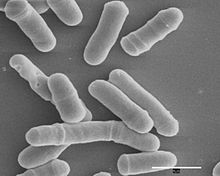粟酒裂殖酵母
粟酒裂殖酵母(学名:Schizosaccharomyces pombe)简称裂殖酵母(fission yeast),为用于酿酒的一种酵母菌,也是分子生物学研究中一种重要的模式生物。本种酵母菌呈杆状,基因组大小约为14Mb,估计有约5000个编码蛋白质的基因与至少450个非编码RNA[2]。
| 粟酒裂殖酵母 | |
|---|---|

| |
| 科学分类 | |
| 界: | 真菌界 Fungi |
| 门: | 子囊菌门 Ascomycota |
| 纲: | 裂殖酵母纲 Schizosaccharomycetes |
| 目: | 裂殖酵母目 Schizosaccharomycetales |
| 科: | 裂殖酵母科 Schizosaccharomycetaceae |
| 属: | 裂殖酵母属 Schizosaccharomyces |
| 种: | 粟酒裂殖酵母 S. pombe
|
| 二名法 | |
| Schizosaccharomyces pombe Lindner (1893)
| |
| 异名[1] | |
| |
粟酒裂殖酵母最早于1893年由德国微生物学家保罗·林德纳自东非的小米啤酒中分离,种小名pombe源于斯瓦希里语的“啤酒”。1950年代瑞士遗传学家乌尔斯·里奥波特使用本种为遗传学研究的模式生物[3][4],后来英国生物学家默多克·密契森使用本种为模式生物研究细胞周期[5][6][7],保罗·纳斯成功将两者结合,使用本种研究细胞周期而获颁2001年的诺贝尔生理学或医学奖。粟酒裂殖酵母的基因组于2002年由桑格研究所领导的团队定序完成,为第6种被完整定序的真核生物(前五种依序为酿酒酵母、秀丽隐杆线虫、黑腹果蝇、阿拉伯芥与人类)[8]。以本种为模式生物的研究人员已建立名为PomBase的模式生物数据库,纪录其基因组序列、各基因名称与位置、与人类基因的同源性等[9]。2006年有研究发表本种所有蛋白在细胞中分布的位置[10]。
与酿酒酵母比较
编辑分子种系发生学研究显示在子囊菌门的演化树中,粟酒裂殖酵母所在的演化支位于较基部的位置,酿酒酵母则位于较深处,与后者相比,粟酒裂殖酵母和两者的共祖较相似,酿酒酵母则累积了较多的演化变异,例如酿酒酵母已失去了超过300个粟酒裂殖酵母与动物共有的基因[13][14],而粟酒裂殖酵母只失去了179个酿酒酵母与动物共有的基因[13]。截至2015年,PomBase纪录粟酒裂殖酵母编码蛋白质的基因有5054个(酿酒酵母则有5821个,但此数目受旁系同源物与酿酒酵母在演化上经历过两次基因组重复事件的影响[13])。粟酒裂殖酵母的基因组长约13.8Mb,与酿酒酵母的12.5Mb接近,但前者只有3个染色体(分别长5.7、4.6与3.5Mb),后者则有16个较小的染色体,其中最大者仅长1.5Mb[13]。另外粟酒裂殖酵母染色体的中节和动物的较为相似,许多两者中节共有的蛋白皆不见于酿酒酵母[13]。
生殖
编辑粟酒裂殖酵母一般仅进行无性生殖,但养分缺乏的逆境可促使其交配而进行有性生殖[15];此外过氧化氢处理(造成氧化压力以破坏DNA)[16]或以其他方式造成DNA位点突变亦可引发其交配[17],显示DNA损伤可能诱发此真菌进行有性生殖以修补DNA[18]。
参考文献
编辑- ^ Schizosaccharomyces pombe. GBIF. Copenhagen, Denmark: GBIF Secretariat. [14 August 2021].
- ^ Wilhelm BT, Marguerat S, Watt S, Schubert F, Wood V, Goodhead I, et al. Dynamic repertoire of a eukaryotic transcriptome surveyed at single-nucleotide resolution. Nature. June 2008, 453 (7199): 1239–43. Bibcode:2008Natur.453.1239W. PMID 18488015. S2CID 205213499. doi:10.1038/nature07002.
- ^ Leupold U. Die Vererbung von Homothallie und Heterothallie bei Schizosaccharomyces pombe. C R Trav Lab Carlsberg Ser Physiol. 1950, 24: 381–480.
- ^ Leupold U. (1993) The origins of Schizosaccharomyces pombe genetics. In: Hall MN, Linder P. eds. The Early Days of Yeast Genetics. New York. Cold Spring Harbor Laboratory Press. p 125–128.
- ^ Mitchison JM. The growth of single cells. I. Schizosaccharomyces pombe. Experimental Cell Research. October 1957, 13 (2): 244–62. PMID 13480293. doi:10.1016/0014-4827(57)90005-8.
- ^ Mitchison JM. The fission yeast, Schizosaccharomyces pombe. BioEssays. April 1990, 12 (4): 189–91. PMID 2185750. doi:10.1002/bies.950120409.
- ^ Fantes PA, Hoffman CS. A Brief History of Schizosaccharomyces pombe Research: A Perspective Over the Past 70 Years. Genetics. June 2016, 203 (2): 621–9. PMC 4896181 . PMID 27270696. doi:10.1534/genetics.116.189407.
- ^ Wood V, Gwilliam R, Rajandream MA, Lyne M, Lyne R, Stewart A, Sgouros J, Peat N, et al. The genome sequence of Schizosaccharomyces pombe. Nature. February 2002, 415 (6874): 871–80. Bibcode:2002Natur.415..871W. PMID 11859360. doi:10.1038/nature724 .
- ^ PomBase. [2022-06-22]. (原始内容存档于2021-12-23).
- ^ Matsuyama A, Arai R, Yashiroda Y, Shirai A, Kamata A, Sekido S, et al. ORFeome cloning and global analysis of protein localization in the fission yeast Schizosaccharomyces pombe. Nature Biotechnology. July 2006, 24 (7): 841–7. PMID 16823372. S2CID 10397608. doi:10.1038/nbt1222.
- ^ Jeffares, Daniel C.; Rallis, Charalampos; Rieux, Adrien; Speed, Doug; Převorovský, Martin; Mourier, Tobias; Marsellach, Francesc X.; Iqbal, Zamin; et al. The genomic and phenotypic diversity of Schizosaccharomyces pombe. Nature Genetics. 2015, 47 (3): 235–241. PMC 4645456 . PMID 25665008. doi:10.1038/ng.3215.
- ^ Teoh AL, Heard G, Cox J. Yeast ecology of Kombucha fermentation. International Journal of Food Microbiology. September 2004, 95 (2): 119–26. PMID 15282124. doi:10.1016/j.ijfoodmicro.2003.12.020.
- ^ 13.0 13.1 13.2 13.3 13.4 Hoffman CS, Wood V, Fantes PA. An Ancient Yeast for Young Geneticists: A Primer on the Schizosaccharomyces pombe Model System.. Genetics. 2015, 201 (2): 403–23. PMC 4596657 . PMID 26447128. doi:10.1534/genetics.115.181503.
- ^ Wood V. How to get the most from fission yeast genome data: a report from the 2006 European Fission Yeast Meeting computing workshop.. Yeast. 2006, 23 (13): 905–12. PMID 17072881. doi:10.1002/yea.1419.
- ^ Davey J. Fusion of a fission yeast. Yeast. December 1998, 14 (16): 1529–66. PMID 9885154. doi:10.1002/(SICI)1097-0061(199812)14:16<1529::AID-YEA357>3.0.CO;2-0.
- ^ Bernstein C, Johns V. Sexual reproduction as a response to H2O2 damage in Schizosaccharomyces pombe. Journal of Bacteriology. April 1989, 171 (4): 1893–7. PMC 209837 . PMID 2703462. doi:10.1128/jb.171.4.1893-1897.1989.
- ^ Pauklin S, Burkert JS, Martin J, Osman F, Weller S, Boulton SJ, et al. Alternative induction of meiotic recombination from single-base lesions of DNA deaminases. Genetics. May 2009, 182 (1): 41–54. PMC 2674839 . PMID 19237686. doi:10.1534/genetics.109.101683.
- ^ Farah JA, Cromie G, Davis L, Steiner WW, Smith GR. Activation of an alternative, rec12 (spo11)-independent pathway of fission yeast meiotic recombination in the absence of a DNA flap endonuclease. Genetics. December 2005, 171 (4): 1499–511. PMC 1456079 . PMID 16118186. doi:10.1534/genetics.105.046821.